It’s the time of year when buds are emerging. It’s also the time of centuries, long awaited, of Israel’s coming to fruition. The re-born nation is celebrating 70 years back in her land. “Can a nation be built in a day?” exclaimed the royal prophet Isaiah at the very end of his grand vision. I am convinced we are living in the time of Israel’s glorious denouement. The evidence is obviously visible: the land is blooming. Many trees, besides the broad-leafed fig, show the fruit of Israel’s 70 year cultivation of the land on the eastern edge of the Mediterranean. They are back where they started. This monotype is a reflection of that further becoming.

Like mirrors which echo imagery down a long corridor, has the fig tree been a watchword in every age for those who have read the Jewish prophet Jesus. Many have longed to see what we are seeing now with our own eyes. Many prophets promised it, and many more eager for the fruit yet to appear.
Before the Roman devastation of the 2ndtemple in Jerusalem, Jesus, from the tribe of Judah, used a fig tree as a metaphor for his nation. It was not the time for harvest. And so the “sign of the fig tree” became a sad precursor to the Roman ruin of the Jewish homeland just decades after Jesus. The tree’s unfruitfulness at that time was a prophetic illustration of what was about to come down.
Now that nation is reborn, and fig trees are blooming again. There is reason for anticipation.
The fig is the third tree mentioned in Genesis, after the tree of life, then the forbidden tree (knowledge of good and evil) that was nonetheless sampled by Eve then Adam. The Fig was the fall-back, not for eating at that point, but for the more desperate need for cover-up. Its broad leaves were grasped and stitched together for now there was an instinctive knowing of inadequacy, a need for costume-ing. It was the first masquerade.
But for the gracious kindness of a seeking God, that is not where the whole story ended, though it could have. And that is precisely why this sign interests me. It wasn’t the poor tree’s fault to be a sign of leafy futility. The fig tree that Jesus spoke of remains a metaphor of what was and what is yet coming: Isael’s long term future toward fruitfulness. He finishes everything He began.
Fig trees are blooming again in the land. And the God of Abraham is still walking around. He’s still asking any who want to care the very first question he posed to mankind in another garden: “where are you?”
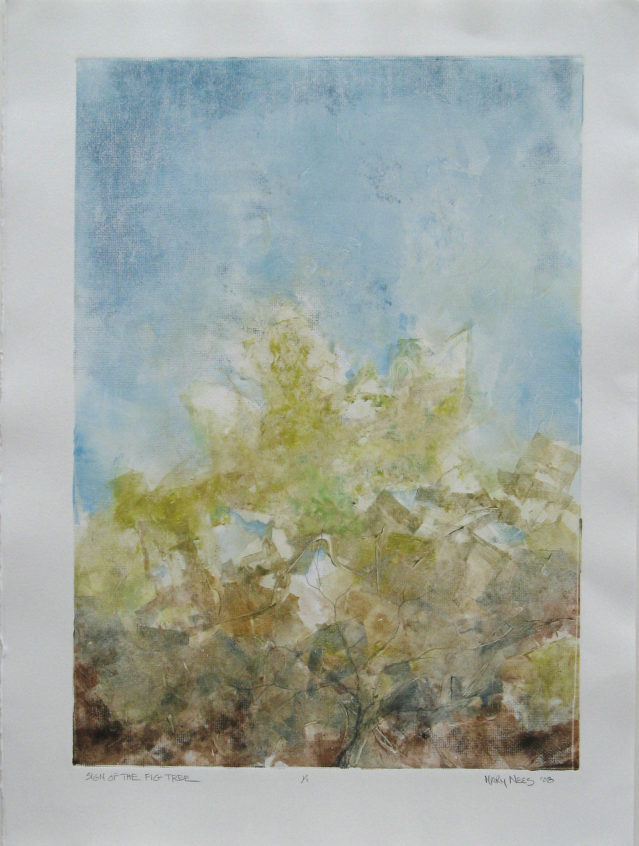

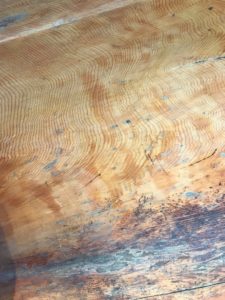 The floor of a red cedar canoe, in the Museum of Anthropology at the University of British Columbia quietly testifies to its own story. Once standing tall and alone in a rain forested wood fringing the Pacific, it was scope-ed out then heavily laid down. Done. Cut off from its nourishment; it was then gouged, steamed and stretched by the hands of others. Soon it was deemed seaworthy, buoyant and bearing. It was now a thing, not a living thing. This lovely tree was un-noticed until it was found useful for the ends of others. It is said that the first nation Indians were careful with trees, making only single slits in bark to preserve a tree’s life.
The floor of a red cedar canoe, in the Museum of Anthropology at the University of British Columbia quietly testifies to its own story. Once standing tall and alone in a rain forested wood fringing the Pacific, it was scope-ed out then heavily laid down. Done. Cut off from its nourishment; it was then gouged, steamed and stretched by the hands of others. Soon it was deemed seaworthy, buoyant and bearing. It was now a thing, not a living thing. This lovely tree was un-noticed until it was found useful for the ends of others. It is said that the first nation Indians were careful with trees, making only single slits in bark to preserve a tree’s life.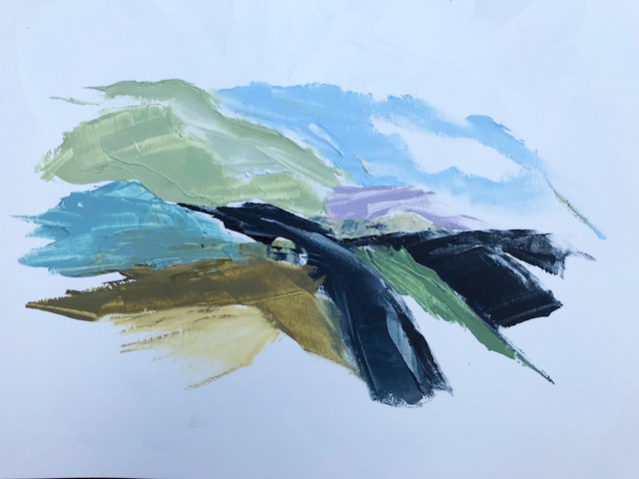
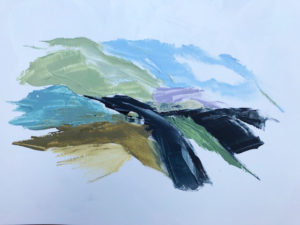 Lord, You have been our dwelling place in all generations.
Lord, You have been our dwelling place in all generations.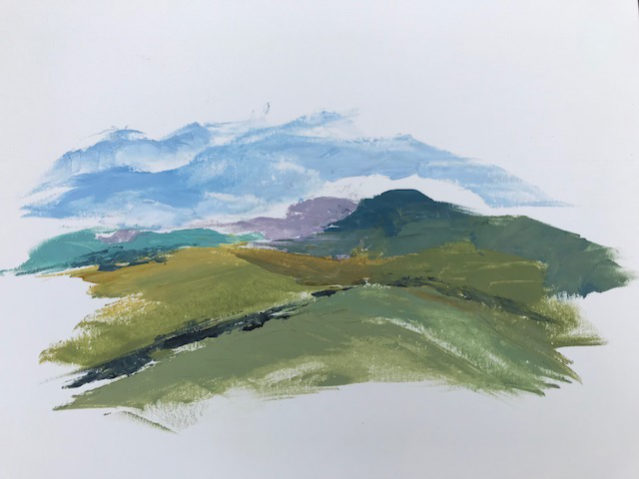
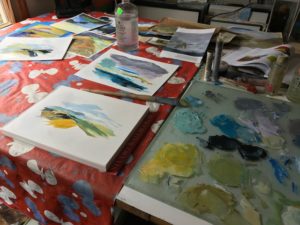 Yesterday in studio I worked up a palette of hues in oil, building from a photo I’d saved of an arctic scene in National Geo. You can see that here if you look closely at my messy table. I mixed up a set of replicated hues, pleasing together, and then added notes of my own with them, before I had any idea what I would do myself with this color grouping.
Yesterday in studio I worked up a palette of hues in oil, building from a photo I’d saved of an arctic scene in National Geo. You can see that here if you look closely at my messy table. I mixed up a set of replicated hues, pleasing together, and then added notes of my own with them, before I had any idea what I would do myself with this color grouping.
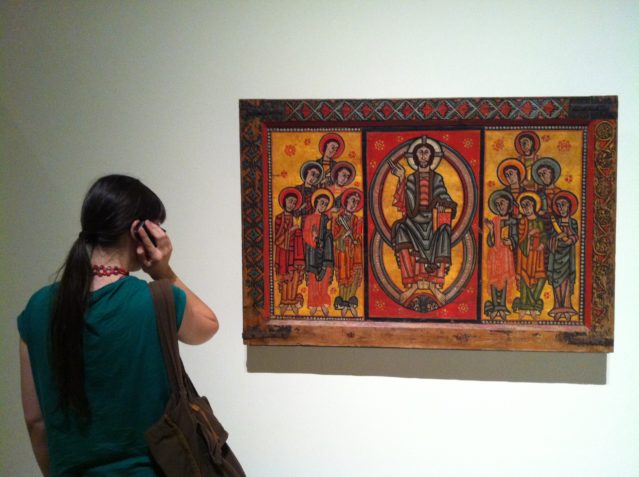
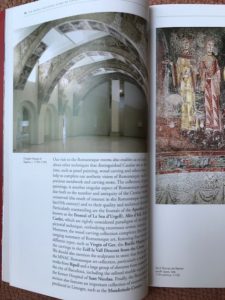 Barcelona’s National Museum of Catalonia has a collection of Romanesque murals that is unmatched by any museum in the world! Room after room gives one almost a time-machine opportunity to enter spaces that were situated in humble towns in the Pyrenees Mountains of Eastern Spain. These murals and sculptural pieces were then carefully removed to be preserved in the museum (imagine the public and private involvement to carry that feat out). Arranged in chronological (therefore stylistic) order, the spaces reveal the emerging imagery from small churches of the medieval period (11th-13thcenturies). What’s available then is a visualization of homegrown private conviction which was developed then displayed for public engagement. What was once internal became publically shared and what was then public becomes privately better understood. And this then down thru centuries for others to consider. Past into present. Imagine that ripple effect.
Barcelona’s National Museum of Catalonia has a collection of Romanesque murals that is unmatched by any museum in the world! Room after room gives one almost a time-machine opportunity to enter spaces that were situated in humble towns in the Pyrenees Mountains of Eastern Spain. These murals and sculptural pieces were then carefully removed to be preserved in the museum (imagine the public and private involvement to carry that feat out). Arranged in chronological (therefore stylistic) order, the spaces reveal the emerging imagery from small churches of the medieval period (11th-13thcenturies). What’s available then is a visualization of homegrown private conviction which was developed then displayed for public engagement. What was once internal became publically shared and what was then public becomes privately better understood. And this then down thru centuries for others to consider. Past into present. Imagine that ripple effect. Here is a wooden altar panel I especially loved for its graphic punch, simplicity, and pattern. It’s a typical example of Byzantine flatness. Yet the abstraction of forms were rendered with human differentiation and quirkiness. The viewer of the time would have been able to relate. And the viewer now is carried into another world’s way of seeing, even if just catching a glimpse. What was private conviction of the artist became embedded in his public context, what simmered inwardly became visible for others to be able to look and see.
Here is a wooden altar panel I especially loved for its graphic punch, simplicity, and pattern. It’s a typical example of Byzantine flatness. Yet the abstraction of forms were rendered with human differentiation and quirkiness. The viewer of the time would have been able to relate. And the viewer now is carried into another world’s way of seeing, even if just catching a glimpse. What was private conviction of the artist became embedded in his public context, what simmered inwardly became visible for others to be able to look and see.

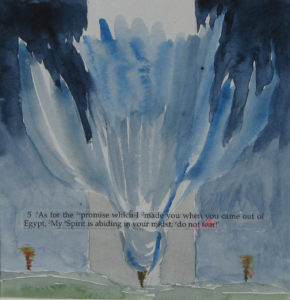
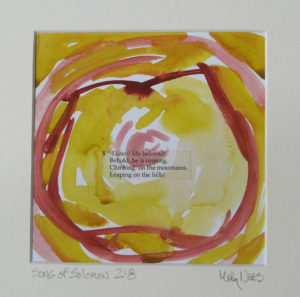 The little ones around us this week are learning to wait. “Can we have Daddy’s cake now that you have come in the door?” “Nini, can I play (bang) on the piano now?!’ “Are you done resting?” “Are you awake?” “Can you tell that story again Pop? Let’s go back in my room and pretend you’re putting me to bed! Tell it to me again, Pop!”
The little ones around us this week are learning to wait. “Can we have Daddy’s cake now that you have come in the door?” “Nini, can I play (bang) on the piano now?!’ “Are you done resting?” “Are you awake?” “Can you tell that story again Pop? Let’s go back in my room and pretend you’re putting me to bed! Tell it to me again, Pop!” Back to earth, there is something in Job’s proclamation that does ring true for me. I have ideas and ambition, but unless my hands get busy, unless I have the courage to learn from the messes, and unless I manifest it somewhere. I have nothin’. Yesterday I picked up from the post office a piece which has been all over the country in a 3 year traveling show:
Back to earth, there is something in Job’s proclamation that does ring true for me. I have ideas and ambition, but unless my hands get busy, unless I have the courage to learn from the messes, and unless I manifest it somewhere. I have nothin’. Yesterday I picked up from the post office a piece which has been all over the country in a 3 year traveling show: 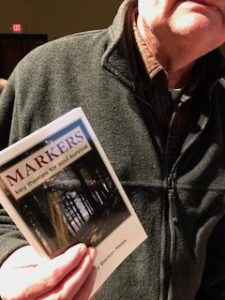
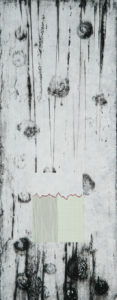 I showed them some pieces like this one, “Time and Mercy” where the chaos is falling down all around the inner life. But there on the inside is the mark of a heartbeat, and the recording of time. There’s a history that is undeniable, part of the fabric that cannot be changed. There’s a span ahead yet unknown. But in this present moment I can breathe and pause. This is the potential moment where beauty is born. For right now I can lift my head because the evidence of love is still shining through for those who are eager for it.
I showed them some pieces like this one, “Time and Mercy” where the chaos is falling down all around the inner life. But there on the inside is the mark of a heartbeat, and the recording of time. There’s a history that is undeniable, part of the fabric that cannot be changed. There’s a span ahead yet unknown. But in this present moment I can breathe and pause. This is the potential moment where beauty is born. For right now I can lift my head because the evidence of love is still shining through for those who are eager for it.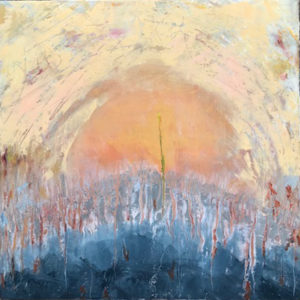 The theme keeps repeating and it’s a universal one. From mythology to classic literature this idea of trekking toward some kind of attainment is in our DNA. Moses, Odysseus, Buddha, Lao Tzu, Dante — the list is long of courageous ones who were answering the ancient quest “where have you come from, and where are you going?”* Something keeps us moving, sometimes for what we’re not even sure; and if our bodies get tired, our spirits keep longing.
The theme keeps repeating and it’s a universal one. From mythology to classic literature this idea of trekking toward some kind of attainment is in our DNA. Moses, Odysseus, Buddha, Lao Tzu, Dante — the list is long of courageous ones who were answering the ancient quest “where have you come from, and where are you going?”* Something keeps us moving, sometimes for what we’re not even sure; and if our bodies get tired, our spirits keep longing.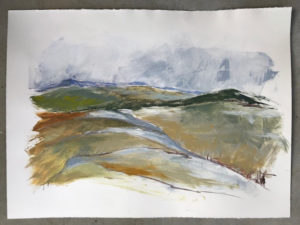 cam. It’s lived so slow from our angle. We move here on the ground at a snail’s response to what is happening second by second in the heavenlies. My sky here is active, for that’s where the real drama is being directed. The land only reflects the weather patterns and the light working above it. I live on the ground, held by gravity, where time creeps sometimes agonizingly slow. I don’t like that slowness, for there’s so much that needs to change down here, so much I long for from the only One who can bring us justice and peace. Humans and their leaders so disappoint me! He said He’d return, why is He taking so long!?
cam. It’s lived so slow from our angle. We move here on the ground at a snail’s response to what is happening second by second in the heavenlies. My sky here is active, for that’s where the real drama is being directed. The land only reflects the weather patterns and the light working above it. I live on the ground, held by gravity, where time creeps sometimes agonizingly slow. I don’t like that slowness, for there’s so much that needs to change down here, so much I long for from the only One who can bring us justice and peace. Humans and their leaders so disappoint me! He said He’d return, why is He taking so long!?